For several years, an observation has imposed itself: digital transformation of the companies is accelerating and affects more and more domains.
Solutions are emerging to help the companies to manage more finely, for example, their product life cycle with PIM (Product Information Management) or their order life cycle with OMS (Order Management System).
This phenomena is a response to the growing pressure at the companies that must follow the more sustained rhythm of technological evolutions etc. The digital transformation aimed at improving and accelerating the process applies to management of contract life cycle (Contract Life Management).
The number of CLM solutions hasn’t stopped increasing from year to year since 2010 to meet the capital needs of the companies: to win in productivity. Thus, a study from 2012 handled by IACCM (International Association for Contract & Commercial Management) shows that bad contract management could represent a 9% loss of the annual revenue for a company..
According to a study by IMARC Group, the market of CLM, estimated to be up to 1,5 billion dollars in 2012, should normally reach 6 billion dollars in 2026.
What is a contract life cycle?
Before diving into details, it is essential to understand what a contract life cycle represents to better identify the contributions of a CLM solution.
The definition of the management of contract life cycle according to Gartner is as followed:
“… A solution is a process allowing management of the contracts’ life cycle created and/or administrated by the company, or having an impact on it. They can include the contracts with Third parties such as subcontracting contracts, provision, sale, non-disclosure of the intellectual property, rental, infrastructure management and any other licence and agreement containing contractual obligations today and in the future.”
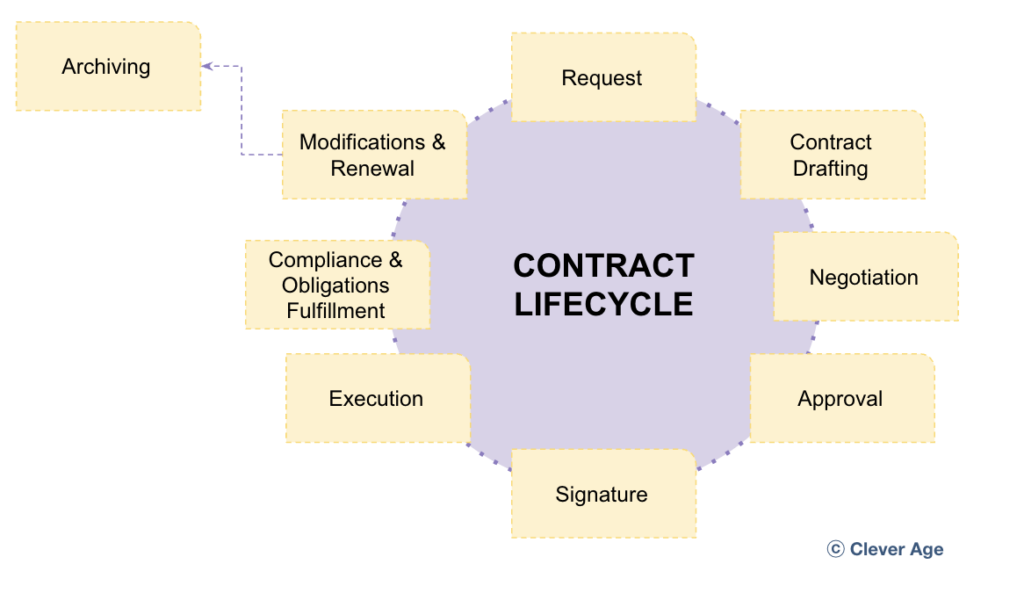
There are 3 main phases in the life cycle of a contract:
- The pre-signature phase
- THe signature phase
- The post-signature phase
THE PRE-SIGNATURE PHASE
- It starts with the request which can involve a response to an AO (Call for Tender) or follow a quote request for example.
- It is followed by a phase of redacting the contract generally internally with multiple repetitions and an important point if the historicization of different versions.
- Then comes the negotiating phase that is often repeated, each part bringing modifications, precisions to the contract.
- After comes the approval phase that sees the client approve the last version of the contract.
THE SIGNATURE PHASE
This phase comes to finalise the contractualisation between the different stakeholders. A phase that could necessitate time if several departments are involved in signing the contract. This could be the case in the international contracts with the obligation to sign the contract at the group and subsidiary level of a company. Or even in the case of signing by the two different services like the administrative service, but also the operational service which will be in charge of implementing/carrying out the contracted service.
THE POST-SIGNATURE PHASE
- This phase starts generally by the implementation of the benefit, contracted service.
- It is followed by the tracking of the contract by ensuring the respect of the terms, obligations (like the respect of ALS for example) or of its conformity (the human means and/or the materials are respected)
- It is finished off by eventual modifications of the contract via the endorsements around a changement of a law for example, or by a revision of the terms. The final step being either the closing of the contract and its archiving, or its renewal.
Like in the case of PIM this life cycle of contracts often requires an intervention of different services of which the collaborative work allows to achieve the version that will be submitted to the client for approval.

The advantages of the CLM solution
WHAT’S DIFFERENT BETWEEN CLM AND CONTRACT LIBRARY?
Often You hear someone talk about contract libraries and a CLM solution, even though these two tools address the management of contracts, their fields stay different, even complementary.
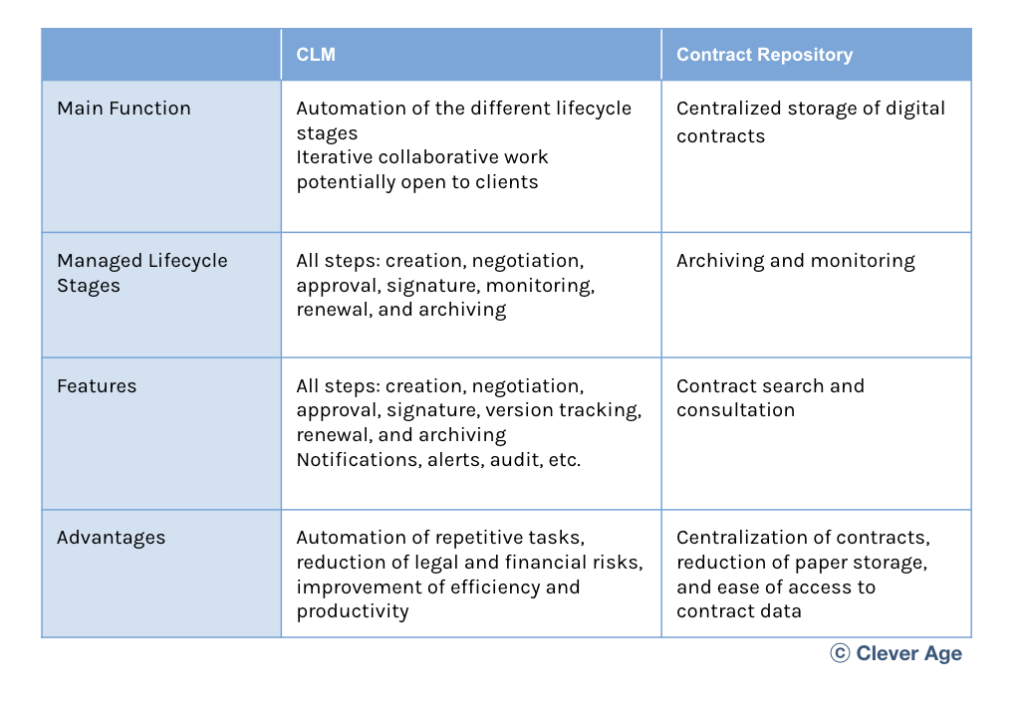
The centralisation of contracts was a truly important topic for several companies, a CLM with its own contract library will be an important criteria.
CONTRIBUTIONS OF A CLM
If we had to summarise the principles of CLM in 3 words, they would be:
CENTRALISE – OPTIMISE – MAKE RELIABLE
A CLM solution offers numerous advantages following different axes:
Winning time: optimisation of the process
- Data centralization
Whether it’s contracts in the contract repository or the clause library listing all clauses according to their field of application. A repository of unique contracts shared by all within the company - Reduction of contract lead time
Creation of contracts from predefined templates incorporating clauses according to the field of application - Automation of repetitive tasks
Reduction of time and resources required for contract management such as automatic sending at different stages of the life cycle - Collaborative work
Setting up a workspace with a defined workflow and assigning tasks to the right people at the right time in the cycle. A shared vision among all of contracts under development
Reduction of risks and conformity
- Identification and prevention of risks and ligitations
Triggering alerts on contract deadlines or the negotiation of critical clauses based on commitments from old contracts. - Compliance control
Control guaranteeing respect of legal norms for each contract. A major issue, particularly with international contracts.
Controlled monitoring
- Versioning et notifications
Management of contracts’ drafts during the pre-signature stage with with notifications to stakeholders of changes. Reduced risks and delays - Renewing and notifications
Proactive management or renewing, expiration of contracts and notifications to the people in charge of contract monitoring - 360° visibility
Visibility of current contracts but also of commitment of past contracts like a knowledge base, shared by everyone.
Visibility and traceability
- Assistance workflows
Salespeople and managers are guided by automatic assistants to creation of contracts and to control of modifications passing by approving workflows - General view
Contractual reference system visible to everyone and at every moment for better tracking management - Traceability
Tracking of modifications made to contracts all along the cycle, with the notifications of interactions and approvals
Savings and profitability
- Costs reduction
On the one hand, the automation of processes reduces administrative costs and on the other, centralization reduces costs by shortening exchange times and contracting times. - Optimisation of contractual clauses
Locate possible improvements of terms of a contract helps to maximise the profitability of agreements - Detailed reports
Strategic decision-making can be supported by detailed reporting on trends, risks and contract performance
Example of the CLM Sirion report:
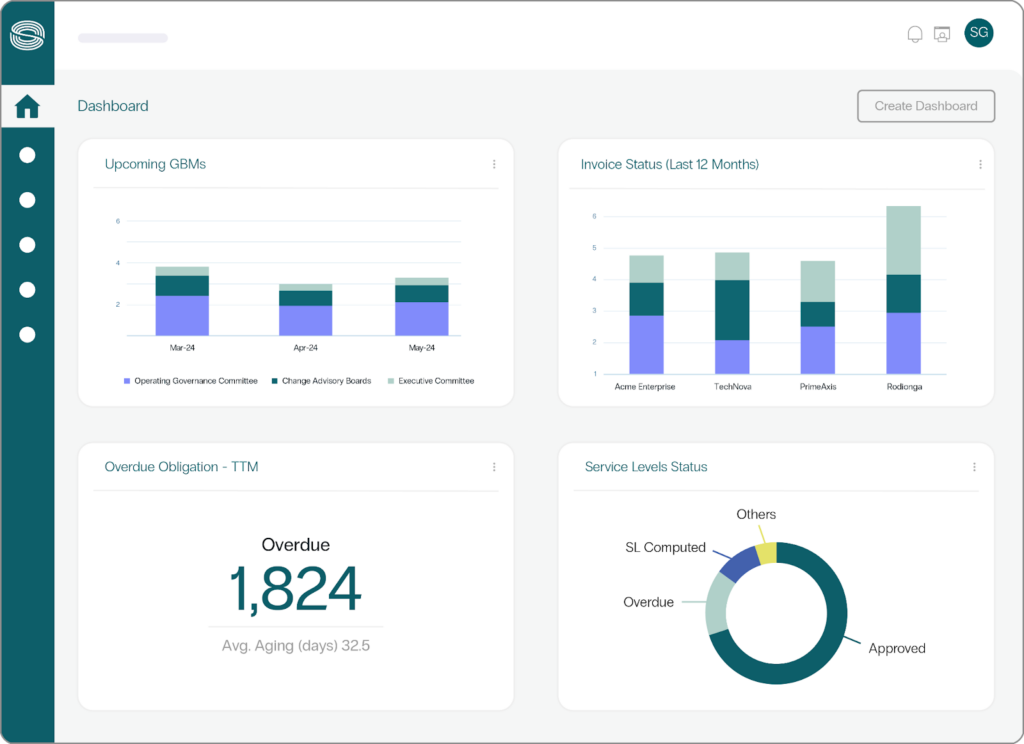
- Predictive analysis
In certain cases, CLM shows capacities of predictive analysis able to anticipate tendencies and facilitate certain decisions.
Integration at the heart of IS
CLM, like any new application, must be integrated into Your IS and find its place to be powered up and diffuse information downstream.
An example of integration shows a CLM:
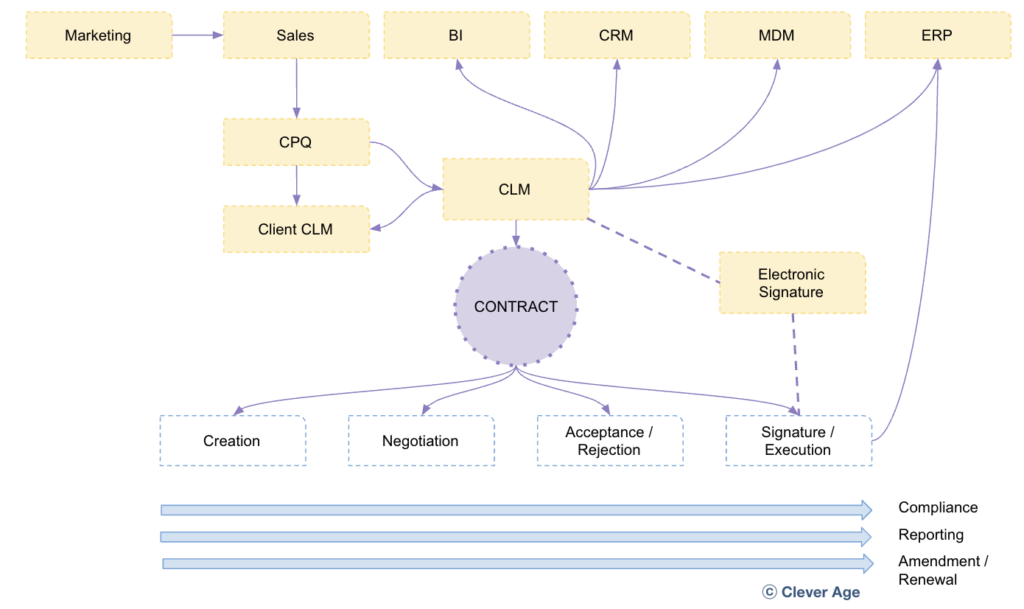
Upstream:
At the entry, CLM is powered by 2 channels:
- A sales force corresponding to the company’s commercial department which approaches customers with a view to obtaining contracts
- CPQ (Configure Price Quote) which is the entry of quotes towards contracting
- Another entry point could be client’s CLM able to provide their own contract model
Downstream:
At the exit CLM can address different blocks:
- A Finance block could be represented by a ERP and which will collect the data of signed contracts in order to calculate and foresee payment deadlines
- A part of Services that could regroup a CRM and/or a MDM to resurface the contracts’ informations on client entities for monitoring and in particular for alerts on contract expiration or renewal
- CLM can also be connected to decisional analysis’ solutions of type BI for example
- CLM can also be connected with customers’ CLM(s) to “push” contracts to them during the approval and signature stages
- Finally, certain CLMs can be connected to electronic signature solutions in case they don’t have this functionality
How does AI contribute to CLM?
Currently, AI is one of the major subjects that is affecting many areas. CLM is no exception to the rule, where we start to talk more and more about Contractual Intelligence. As we saw before, the strength of a CLM is in particular to automate a number of repetitive and often tedious tasks. AI represents a significant contribution to this sector.
A White paper published in 2023 by Wolters Kluwer covers the subject of AI in juridical service in the field of contract management. A graphic on itself summarises the repartition of automatism, AI and human intervention at the cycle of contract management. (source : https://www.village-justice.com/articles/comment-accelere-analyse-revision-des-contrats,45773.html)

Something to keep from this, is that AI brings all its power on the tasks of contracts’ control and conformity.
In fact, once the contract has integrated in CLM, AI will be able to analyse it:
- By locating clauses and comparing them with those pre-defined by the company
- By comparing the model of the contract and its coherence with the previous contracts in the same field
- By verifying certain sources, especially if there are specific clauses with suppliers
This analysis then provides a confidence index on the contract which the human will be able to validate/invalidate. Certain CLM solutions save a considerable saving of time in stages with integration of AI, where 3 hours of reading is reduced to 45 minutes of verification of AI’s analysis.
Since then, an AI engine has become a differentiator element between two CLMs.
Example with AI of CLM Icertis:
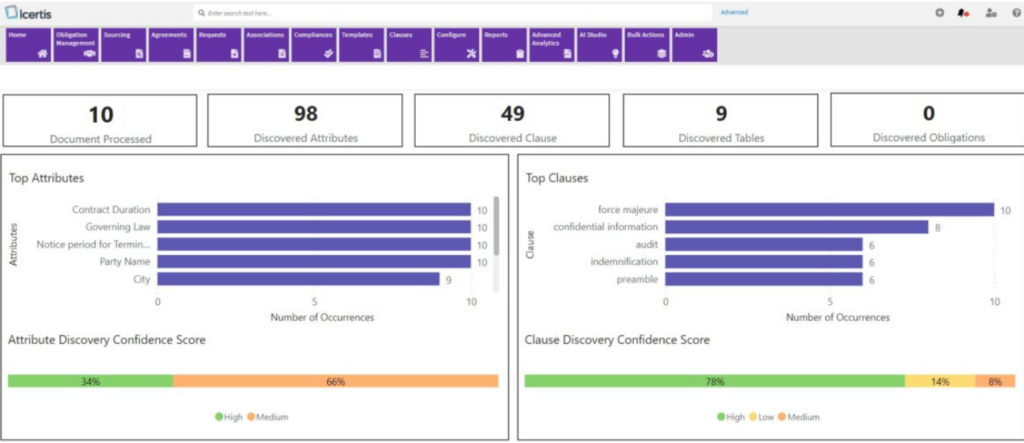
How to choose your CLM solution?
We have already mentioned it, the CLM market is in full explosion and it counts about 200 CLM. In fact, making a choice can be complicated and as a first approach it may be interesting to rely on studies such as the latest Gartner report from 2023 on CLM.
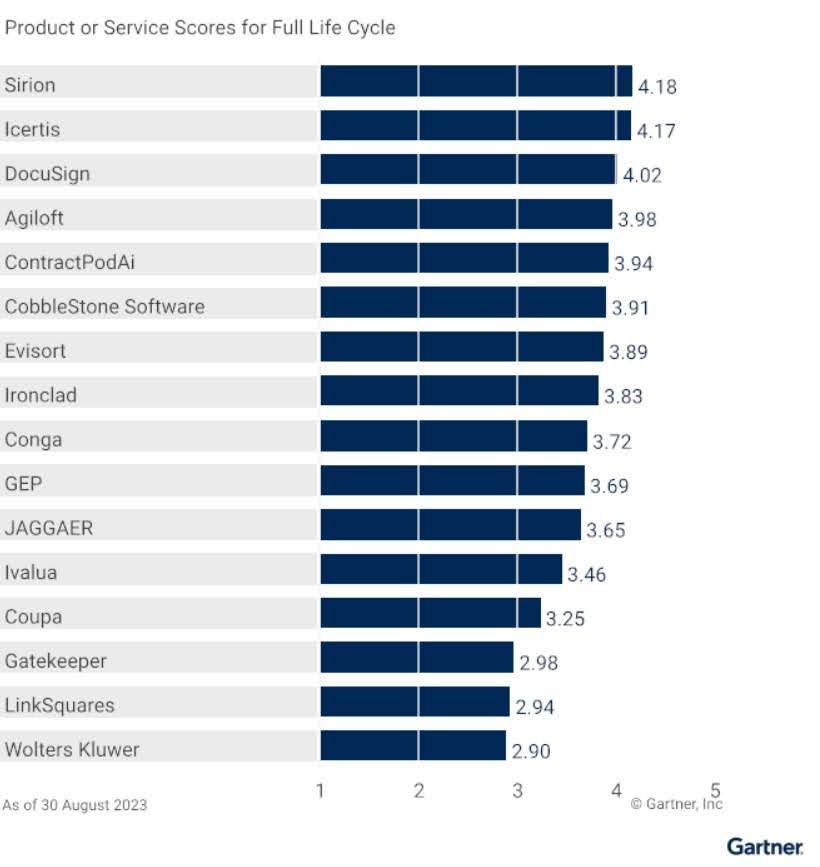
The first primary stage is to define the needs of Your company by consulting concerned parties: commercial management, juridical management, operational management, informatics etc.
Analyse Your current processes, their limits, their shortcomings, because these are the elements that will enrich Your bill of specifications.
Benchmarking different CLm solutions requires the definitions of good comparison criterias. Here is a non-exhaustive list of those:
Functional Scope
- Contract digitization, especially from paper or scanned contracts for quick and efficient integration
- Contract library to structure centralised contract storage
- Clause repository to store all clauses classified by domain
- Versioning history that allows working on drafts in all pre-signature stages
- Configurable workflow to set up steps based on Your processes and coupled with a notification and alert system
- Real-time negotiation to bring together all internal parties of the company and the final customer around the same document
- An electronic signature tool to secure the signature by all signatories
- An AI tool to assist teams in control/verification of a contract and in some cases provide predictive analysis
- Reporting and analysis tool to track the KPIs you have defined and use CLM in a continuous improvement approach.
A point that makes a difference between the solutions is often the post-signature stage, that is more-less well addressed.
- Activity domain:
- It is important to know that CLMs are usually addressed and efficient for given activity domains.
- Thus the CLMs:
- **Sirion and DocuSign are more focused on bank, real estate, communication/media and manufacturer industry types of customers
- Agiloft addresses the medical, scientific, fabrication and communication types of customers
- UX/UI
It is important not to neglect the “user friendly” orientation of a solution which will make it easier to adhere to - Interoperability
A CLM solution with connectors compatible with your CRM/ERP solutions would be a plus, or at least having a wealth of usable APIs - Model of solution
Choose between On premise (hosted at home or with a host), SaaS or PaaS (hosting and outsourcing by the solution publisher) Knowing that the current tendency leans towards SaaS model for numbers of actors. - Security
A CLM managing contracts and being able to be a portal for your customers, security remains a major element. Depending on Your case, certain certifications can be necessary like certification SO C2 or, if You grow to international level, the certification FedRAMP or the HIPAA norm if You are in the healthcare field in USA for example. - Cost
Licensing fees, installation fees, training fees, and maintenance and support costs should be taken into account. - Editor support
A differentiating point between 2 solutions may depend on the quality of customer service and support. Thus, a publisher based in the USA with its support in India will be at a disadvantage only if you are French and looking for a CLM for your activity in France.
Conclusion
The CLM market is a field full of explosion bringing an answer to companies and organisations who wish to modernise their contract management and abandon paper or Excel contract management. The other challenge remains to centralise all the documents which, currently, are most often scattered everywhere.
CLM proposes to the juridical and commercial services the same profit as PIM for marketing service: the promise to spend less time on tasks to concentrate on complex cases, non-automatable and providing additional value.
It is therefore appropriate to choose the solution best suited to your market and its processes while keeping in mind that this is also a project where change management is essential and key to success.
So, ready to start? We are here for Your support:



